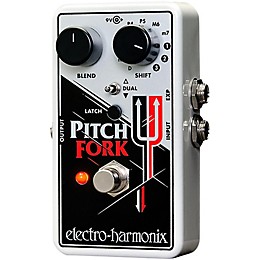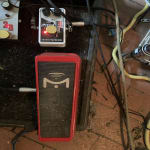- Popular Brands
Electro-Harmonix Pitch Fork Polyphonic Pitch Shifting Guitar Effects Pedal
Videos (2)
View All

Ambient Guitar Swells: Pitch Fork


Electro-Harmonix Pitch Fork

 Description
Description
The controls are straightforward and intuitive. An 11-position Shift switch selects the maximum transposition interval ranging from D (Detune), a shift of 17 cents, through Minor 2nd, Major 2nd, Major 3rd, Perfect 4th, Perfect 5th, Major 6th, Minor 7th, 1 Octave, 2 Octaves and 3 Octaves. A three-position toggle switch controls whether the pitch is transposed up, down or both. In Dual mode, two pitch-shifted signals are output. One follows the shift knob as if in the Up position while the other creates a harmony. Dual Mode settings include M3 up + P5 up, P5 up + 1 Oct down, 1 Oct up + 1 Oct down and many others. A Blend knob controls the mix of the dry signal and the effected signal, and an EXP jack enables the player to control pitch and glissando with an expression pedal.
The Latch button selects Latch or Momentary mode, which affects how the footswitch and EXP input behave. In Latch mode, the footswitch toggles between effect on and buffered bypass each time it's pressed, and the EXP input continuously varies pitch. In Momentary mode the effect is only on while the footswitch is depressed and when it is released the Pitch Fork goes into bypass.
In Latch mode the EXP input controls pitch shift amount, ranging from unity to the interval set by the Shift knob, and pitch varies continuously throughout the expression pedal's range. In Momentary mode the EXP input controls glissando rate for the Pitch Fork's footswitch. When the bypass footswitch is pressed, the Pitch Fork jumps from bypass to the interval set by the Shift knob. The amount of time it takes to reach that new note is the glissando rate. When the footswitch is released the pitch will return to unity at the same rate. That glissando time can vary between four milliseconds to two seconds depending on the heel/toe position of the expression pedal. The default glissando rate is 60 milliseconds when nothing is plugged into the EXP input.
The Pitch Fork comes equipped with an EHX 9.6DC-200mA power supply and also runs on a 9-volt battery.

 Features
Features
- Transposes over a +/- three-octave range
- Three shift modes: up, down or dual
- 11-position Shift knob selects the transposition interval
- EXP input lets you control pitch shift or glissando via optional expression pedal
- Latch and Momentary modes affect how the footswitch and EXP input behave
- Comes with EHX 9.6DC-200mA AC Adapter, can also run off a 9V battery
 Warranty
Warranty
Featured Articles
 Reviews
Reviews
4.38
21 Reviews
82%
of respondents would recommend this to a friend
Most Liked Positive Review
Pair with a Mission EP-1 for best results
I use this with a Mission EP-1. I got this instead of a whammy pedal for its polyphonic capabilities and smaller footprint. With an expression pedal it's incredibly versatile. The pedal does color your tone a bit when it's switched on. As far as I can tell, it compresses the guitar signal slightly. It does not sound bad at all. I'm hugely influenced by Trey Anastasio and I use this setup the same way he uses his whammy pedal, which is mostly for down-bends when playing lead, with the occasional octave effect. When playing with an expression pedal, when you start to bend towards the end of the effect range, tracking starts to lag a bit. Since I don't use this for detuning, this really isn't an issue for me. For whole step down bends and octaves this thing is absolutely killer, however I have an AnalogMan CompROSSor on the way that I'm going to put directly after this to hopefully help even out the subtle variations in tone through the range of the effect. Trey uses this to his advantage with his whammy pedal, but I also plan to use this for the occasional faux slide lick and the compressor should really help make it sound more authentic, like how Jimmy Herring uses his whammy bar. With the Mission EP-1 the setup ends up being more expensive than a digitech whammy pedal, but I think it works better, having owned a whammy pedal in the past. I can see how some of this pedal's shortcomings could be dealbreakers for some players. I would not recommend it for detuning, but for everything I use it for, it's vastly superior to the digitech whammy pedal.
Most Liked Negative Review
Close but no cigar
I got this yesterday so I wouldn't have to tune down all my guitars to Eb for my classic rock band. I tried to use the built in harmonizer in my Line 6 Helix, and It didn't cut it so I decided I'd give the Pitch Fork a try. All I needed it to do was drop my guitar a half step. I would have gotten the Digitech Drop, however it was on back order. So the pitch Fork was my choice. I got it home, plugged it in, and hit an A chord. It sounded ok. Then some high lead up into the 12-16 fret. I am returning it today. To my ear (And I don't have the finest ear either) once I hit the 15th note high bend it sounded like a synthesizer, very unnatural, The Helix did a much better job at doing the same thing, and it's not good enough imo either. I may try the Digitech Drop once it's back in stock, but I'll try it in store first, and maybe save myself a return trip. I'm not very hopeful that the Digitech will work much better but I'll try it before I put 10's on my de-tuned guitars.
- Performances8
- Amateur Recording5
- Home Studio5
- Outdoor Events / Games4
- Professional Recording4
- Poor Sound Quality3
- Reverb Effect Built In1
- Volume Boost of 3-5 Decibles1
- A little noisy1
- Experienced11
- Professional Musician5
- Novice2
- Excellent Sound Quality13
- Compact12
- Versatile12
- Good Selection Of Effects9
- Responsive9
Reviewed by 21 customers
Everything I hoped for
Verified Buyer
submitteda year ago
byLane
fromDallas, Texas
Submitted as part of a sweepstakes
I play rythm guitar in church on Sunday mornings. I have been doing this for almost 25 years. I am not a pro, but I enjoy the opportunity to play weekly. I can play in most keys, but tend to struggle when playing in "flats." I always capo a single fret and play in the ransposed key (I can transpose the shords in my head). Now instead of using the capo (which could tend to impact tuning), I press the button and it's done. Much easier to click when needed between songs which can transition quickly. There may be some difference in the sound but it is very negligible. I compared to some other products, but they were limited to the ability to de-tune. I looked at the "plus" version, but this was all I needed to meet me goal.
Just what the doctor ordered! Ever try to de-tune a strat!
Verified Buyer
submitted4 years ago
byKeith R.
fromChicago, IL.
It is SO important to be able to do songs in the keys they are written in without having to bring exta guitars out for 1 or 2 songs.
Pair with a Mission EP-1 for best results
submitted5 years ago
byERockwell505
fromAlbuquerque NM
I use this with a Mission EP-1. I got this instead of a whammy pedal for its polyphonic capabilities and smaller footprint. With an expression pedal it's incredibly versatile. The pedal does color your tone a bit when it's switched on. As far as I can tell, it compresses the guitar signal slightly. It does not sound bad at all. I'm hugely influenced by Trey Anastasio and I use this setup the same way he uses his whammy pedal, which is mostly for down-bends when playing lead, with the occasional octave effect. When playing with an expression pedal, when you start to bend towards the end of the effect range, tracking starts to lag a bit. Since I don't use this for detuning, this really isn't an issue for me. For whole step down bends and octaves this thing is absolutely killer, however I have an AnalogMan CompROSSor on the way that I'm going to put directly after this to hopefully help even out the subtle variations in tone through the range of the effect. Trey uses this to his advantage with his whammy pedal, but I also plan to use this for the occasional faux slide lick and the compressor should really help make it sound more authentic, like how Jimmy Herring uses his whammy bar. With the Mission EP-1 the setup ends up being more expensive than a digitech whammy pedal, but I think it works better, having owned a whammy pedal in the past. I can see how some of this pedal's shortcomings could be dealbreakers for some players. I would not recommend it for detuning, but for everything I use it for, it's vastly superior to the digitech whammy pedal.
Harmonizer on my pedalboard, oh my!!
submitted5 years ago
byBenn
fromMorrisdale
I've always wanted one of these. After some research, I ended up with this one. Can go up too 3 octaves in either direction, or high and low at once. Tracks great. Play as fast as you want this thing is fluid. Good selection of intervals to chose from. A little pricey but you can add a expression pedal for whammy effect! ($95) extra. Other then that, she's a keeper. Comes with power supply
It's a toy.
submitted5 years ago
byKramerguy
fromPennsylvania
Saw a youtube video, thought the possibilities were exciting. The person who demo'd said you could use it to emulate different tunings, which excited me, as being in a cover band that plays everything from drop C to standard, it's always a hassle to re-tune between songs and sets and bring extra guitars, etc. Maybe I should be surprised that it could be used in that fashion, and it certainly did. The problem was the tone.. it's a complete tone-suck. If you play through really high end guitar and amp, what this pedal will do is turn your tone into a screechy pile of garbage. Sorry EHX, but I find this truth in a lot of your emulation pedals.
Clean and quiet
submitted6 years ago
bytrashy t
fromColumbus Ohio
It's a useful tool
 Q&A
Q&A
Have a question about this product? Our expert Gear Advisers have the answers.
No results but…
You can be the first to ask a new question.
It may be Answered within 48 hours.




